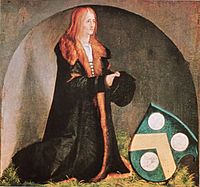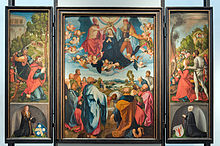Jakob Heller
Jakob Heller (* approx. 1460 in Frankfurt am Main ; † January 28, 1522 there ) was a Frankfurt patrician and councilor . He held the office of Senior Mayor of the Free Imperial City of Frankfurt several times . He used his significant fortune for numerous religious and artistic foundations , including the famous Heller Altarpiece by Albrecht Dürer and Mathias Grünewald .
Life
Jakob Heller was born in Frankfurt am Main around 1460. He came from a family that had risen from the craftsman class to the patriciate and made a considerable fortune through the cloth trade . His parents were the businessman and councilor Bechthold Heller and Katharina Blum . From this marriage there were 12 sons and seven daughters.
Jakob Heller was a respected businessman who since 1483 the ganerbschaft to Frauenstein belonged. In 1485 he became a councilor and in 1494 a lay judge.
In 1490 he was the junior mayor , 1501 and 1513 senior mayor of Frankfurt. Heller successfully represented the city on several imperial diets , for example in Augsburg in 1510 and in Cologne in 1512 . In 1515 he met Emperor Maximilian I in Worms , who valued him as a consultant and financier.
Heller was the owner of the Hellerhof , an estate west of the city in what is now Gallus , and the Nuremberg court in the old town , where the Nuremberg merchants took up quarters during the Frankfurt trade fairs . In 1517, during his last stay in Frankfurt, Emperor Maximilian lived with Heller in the Nuremberg court.
He was married to Katharina von Melem , the eldest daughter Johann von Melems . The marriage remained childless. Jakob Heller died on January 28, 1522 in his hometown. He was buried next to his wife, who died in 1518, in the Dominican church . With him, the Heller family died out.
meaning
Jakob Heller left behind an extensive will, drawn up in 1519 after the death of his wife, in which he precisely enumerated all bequests and foundations. His records give an accurate picture of the social and religious beliefs of the patriciate shortly before the beginning of the Reformation .
Brighter than art patrons
Among the works of art donated by him, the crucifixion group created in 1509 by Hans Backoffen for the Bartholomäuskirche , installed in the tower hall, should be emphasized, but above all the Heller altar painted in 1508 by Albrecht Dürer and Mathias Grünewald for the Dominican church , a representation of the Ascension and the coronation Mary's . The picture later came to Munich , where it was destroyed in a fire in 1729. A contemporary copy is now in the Historical Museum . Jakob Heller is shown on the left wing in the picture below, his wife Katharina von Melem on the right wing.
Heller had made the acquaintance of Dürer in Nuremberg in 1507 , where he had various connections as a cloth merchant and owner of the Nuremberg court. In his nine letters to his client, preserved in copies, Dürer gives important information about his way of working.
Foundations and legacies
In 1510, Heller sold the Viole house to the city council . It was integrated into the town hall complex, the Römer , and served as an archive and city library in the future. At the beginning of the 20th century it was demolished together with its neighboring houses in Frauenrode and Schwarzenstein for a historicizing new building.
A street in the Dornbusch district of Frankfurt was named after Jakob Heller after the Second World War .
literature
- Friedrich Bothe , Das Testament des Frankfurter Großkaufmanns Jakob Heller from the year 1519. A contribution to the characteristics of the bourgeois fortunes and the bourgeois culture at the end of the Middle Ages , in: Archive for Frankfurt's History and Art (AFGK) 28, 1907, pp. 339-401
- Wolfgang Klötzer (Hrsg.): Frankfurter Biographie . Personal history lexicon . First volume. A – L (= publications of the Frankfurt Historical Commission . Volume XIX , no. 1 ). Waldemar Kramer, Frankfurt am Main 1994, ISBN 3-7829-0444-3 .
- Wolfgang Schmid, Jakob Heller as founder and client, in: Grünewald and his time. Cat. Karlsruhe 2007, pp. 48-57
- Rudolf Jung : Heller, Jakob . In: Allgemeine Deutsche Biographie (ADB). Volume 50, Duncker & Humblot, Leipzig 1905, p. 164 f.
- Dietrich Andernacht : Heller, Jakob. In: New German Biography (NDB). Volume 8, Duncker & Humblot, Berlin 1969, ISBN 3-428-00189-3 , p. 479 ( digitized version ).
| personal data | |
|---|---|
| SURNAME | Heller, Jakob |
| BRIEF DESCRIPTION | Frankfurt patrician, councilor and mayor |
| DATE OF BIRTH | 1460 |
| PLACE OF BIRTH | Frankfurt am Main |
| DATE OF DEATH | January 28, 1522 |
| Place of death | Frankfurt am Main |


